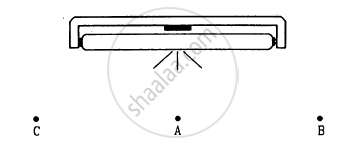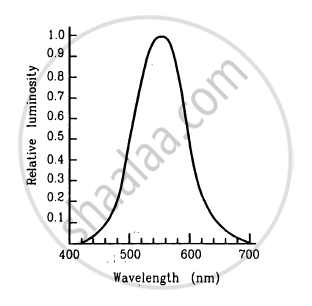Advertisements
Advertisements
प्रश्न
A photographic plate is placed directly in front of a small diffused source in the shape of a circular disc. It takes 12s to get a good exposure. If the source is rotated by 60° about one of its diameter, the time needed to get the same exposure will be ___________ .
पर्याय
6s
12s
24s
48s
उत्तर
24s
Here,
\[ t_1 = 12 s\]
\[ \theta_1 = 0^0 \]
\[ \theta_2 = {60}^0 \]
\[ t_2 = ?\]
Let the distance be r.
Let the incident luminosity be \[E_o.\]
We have,
\[ E_\theta1 = \frac{E_o {\cos\theta}_1}{r^2}\]
\[ t_1 \alpha \frac{1}{E_\theta1}\]
\[ \Rightarrow t_1 = \frac{r^2 k}{E_o {\cos\theta}_1}\]
\[ \Rightarrow 12 = \frac{r^2 k}{E_o \cos0}\]
\[ \Rightarrow \frac{r^2 k}{E_o} = 12\]
Similarly,
\[ t_2 = \frac{r^2 k}{E_o {\cos\theta}_2} = \frac{12}{\cos( {60}^0 )}\]
\[ \Rightarrow t_2 = 12 \times 2 = 24 s\]
APPEARS IN
संबंधित प्रश्न
Light is incident normally on a small plane surface. If the surface is rotated by an angle of 30° about the incident light, does the illuminance of the surface increase, decreases or remain same? Does your answer change if the light did not fall normally on the surface?
A bulb is hanging over a table. At which portion of the table is the illuminance maximum? If a plane mirror is placed above the bulb facing the table, will the illuminance on the table increase?
Three light sources A, B and C emit equal amount of radiant energy per unit time. The wavelengths emitted by the three source are 450 nm, 555 nm and 700 nm respectively. The brightness sensed by an eye for the sources are XA, XB and XC respectively. Then, ________ .
As the wavelength is increased from violet to red, the luminosity ____________ .
Figure shows a glowing mercury tube. The intensities at point A, B and C are related as __________ .

The brightness-producing capacity of a source
(a) does not depend on its power
(b) does not depend on the wavelength emitted
(c) depends on its power
(d) depends on the wavelength emitted
A room is illuminated by an extended source. The illuminance at a particular portion of a wall can be increased by
(a) moving the source
(b) rotating the source
(c) bringing some mirrors in proper positions
(d) changing the colour of the source.
Mark the correct options.
(a) The luminous efficiency of a monochromatic source is always greater than that of a white light source of same power.
(b) The luminous efficiency of a monochromatic source of wavelength 555 nm is always greater than that of a white light source of same power.
(c) The illuminating power of a monochromatic source of wavelength 555 nm is always greater than that of a white light source of same power.
(d) The illuminating power of a monochromatic source is always greater than that of a white light source of same power.
A photographic plate records sufficiently intense lines when it is exposed for 12 s to a source of 10 W. How long should it be exposed to a 12 W source radiating the light of same colour to get equally intense lines?
Using figure, find the relative luminosity of wavelength (a) 480 nm, (b) 520 nm (c) 580 nm and (d) 600 nm.
The luminous flux of a monochromatic source of 1 W is 450 lumen watt−1. Find the relative luminosity at the wavelength emitted.
A source emits light of wavelengths 555 nm and 600 nm. The radiant flux of the 555 nm part is 40 W and of the 600 nm part is 30 W. The relative luminosity at 600 nm is 0.6. Find (a) the total radiant flux, (b) the total luminous flux, (c) the luminous efficiency.
A light source emits monochromatic light of 555 nwavelengthm. The source consumes 100 W of electric power and emits 35 W of radiant flux. Calculate the overall luminous efficiency.
A source emits 31.4 W of radiant flux distributed uniformly in all directions. The luminous efficiency is 60 lumen watt−1. What is the luminous intensity of the source?
A point source emitting light uniformly in all directions is placed 60 cm above a table-top. The illuminance at a point on the table-top, directly below the source, is 15 lux. Find the illuminance at a point on the table-top 80 cm away from the first point.
Choose the correct answer from given options
Photo diodes are used to detect
Light rays from a point object ______.
